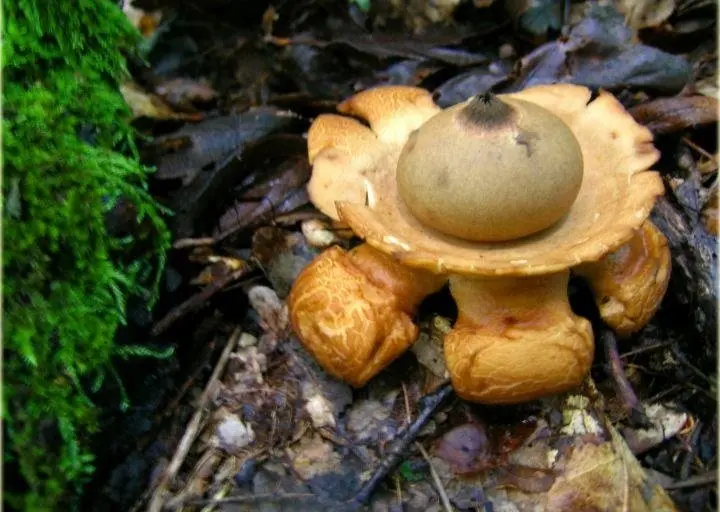Geastrum triplex (Geastrum triplex)
- Division: Basidiomycota (Basidiomycetes)
- Subdivision: Agaricomycotina (Agaricomycetes)
- Class: Agaricomycetes (Agaricomycetes)
- Subclass: Phallomycetidae (Velkovye)
- Order: Geastrales (Geastral)
- Family: Geastraceae (Geastraceae or Stars)
- Genus: Geastrum (Geastrum or Zvezdovik)
- Type: Geastrum triplex (Geastrum triple)

fruiting body:
in a young fungus, the fruiting body is rounded with a sharp tubercle. The height of the fruiting body is up to five cm, the diameter is up to 3,5 centimeters. As the mushroom matures, the outer layer breaks into several thick lobed pieces, beige and terracotta. The diameter of the fruiting body in expanded form can reach 12 centimeters. The central part of the inner layer is preserved as a cupped collar under a slightly flattened sessile outer layer.
An opening is formed in the upper part of the endoperidium through which mature spores enter the outside. In some stellate fungi, a slight depression may appear around the peristome, which is somewhat different from the rest of the outer layer. This area adjacent to the hole is called the courtyard.
In Geastrum Triple, this courtyard is quite wide and clearly defined. The courtyard is surrounded by a ragged opening, which is tightly closed in young specimens. If a young fruiting body is cut exactly in the middle, then in its center you can find a light zone resembling a column in shape. The base of this column rests on the lower part of the fruiting body.
Disputes:
warty, spherical, brown.
Pulp:
The pulp of the inner layer is fragile, juicy and soft. In the outer layer, the pulp is more dense, elastic and leathery. The interior of the endoperidium may be fibrous and entire, or powdery, consisting of capillium and spores.
Spread:
Geastrum triple is found in deciduous and mixed forests. Grows among fallen needles and leaves. Fruits in late summer and autumn. Often fruiting bodies are stored until the next year. Mushroom is cosmopolitan. This species usually grows in large groups, sometimes even hundreds of specimens. It is often possible to simultaneously observe mushrooms at different stages of development.
Edibility:
is not used for food.
Similarity:
Due to its characteristic triple appearance, fully opened fruiting bodies of this fungus are difficult to mistake for related species. But, in the initial stage of opening, the fungus can be confused with other large starfish.









